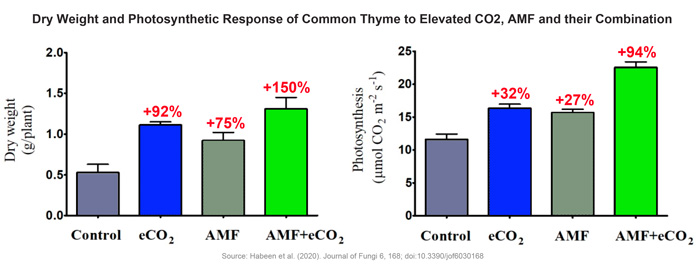| Tweet | Follow @co2science |
Paper Reviewed
Habeeb, T.H., Abdel-Mawgoud, M., Yehia, R.S., Khalil, A.M.A., Saleh, A.M., and AbdElgawad, H. 2020. Interactive impact of arbuscular mycorrhizal fungi and elevated CO2 on growth and functional food value of Thymus vulgare. Journal of Fungi 6, 168; doi:10.3390/jof6030168.
Introducing their work, Habeeb et al. (2020) write that common thyme (Thymus vulgaris) is widely used as a remedy for "treatment of several diseases like bedwetting, diarrhea, stomach ache, arthritis, sore throat, cough, bronchitis and chest congestion." In addition, thyme contains essential oils that have been "extensively studied for antioxidant, antimicrobial and antitumor activities." Recognizing the above facts, the group of six Middle Eastern scientists say "improving the accumulation of these phytochemicals in T. vulgaris could support its nutritional, medicinal and pharmacological properties." And so it was that the authors set out to investigate the individual and combined impacts of elevated CO2 and arbuscular mycorrhizal fungi (AMF) on thyme, as both of these parameters have been shown in prior studies to improve the growth, development and nutritional quality of medicinal herbs (see, for example, the many studies reverenced in our Subject Index under the topic Health Effects of Carbon Dioxide: Health-Promoting Substances, Medicinal Plants).
The experiment was conducted in a controlled-environment greenhouse, where T. vulgaris plants were grown from seed in pots for six weeks under ambient (410 ppm) or elevated (620 ppm) levels of atmospheric CO2 in the presence or absence of AMF (inoculated with Rhizophagus irregularis). Results of the study revealed elevated CO2 and AMF, alone and in combination, stimulated plant photosynthesis and growth (see Figure 1). More specifically, relative to control conditions plant photosynthesis improved by 27% under AMF alone, 32% under elevated CO2 alone and 94% in the combined elevated CO2 and AMF treatment. Similarly, plant dry weight increased by 75% in the AMF treatment, 92% in the elevated CO2 treatment and by a whopping 150% in the combined elevated CO2 and AMF treatment.
But the good news does not stop here. Habeeb et al. report the above positive enhancements led to additional improvements, including a "higher accumulation of primary (sugars, amino acids, fatty acids and organic acids), and secondary (phenolic acids, flavonoids and volatile oils) metabolites," which higher accumulation is known to improve thyme nutritive value and "play an important role in curing several ailments." Consequently, they conclude the "co-application of AMF and elevated CO2 induces a synergistic biofertilization impact and enhances the functional food value of T. vulgare by affecting its global metabolism." Thus, the nutritional and health-promoting values of thyme will be improved in the future under the singular or co-application of rising atmospheric CO2 and AMF.

Figure 1. Dry weight (left panel) and photosynthetic (right panel) responses of common thyme to elevated CO2, AMF and their combination. Red percentages indicated the dry weight or photosynthetic increases relative to control conditions. Source: Habeeb et al. (2020).




